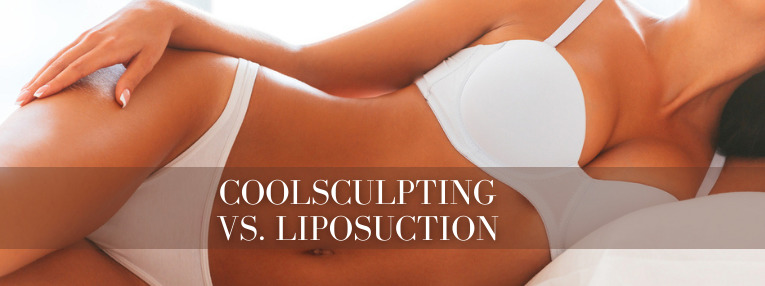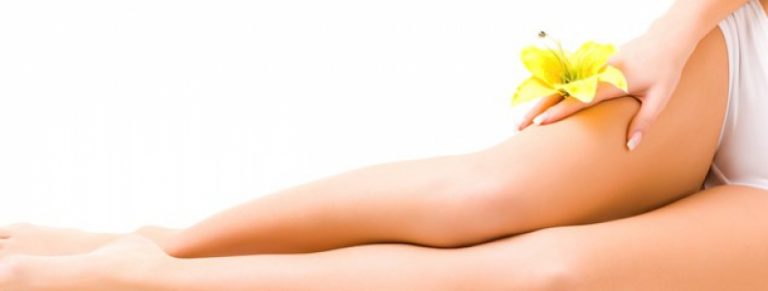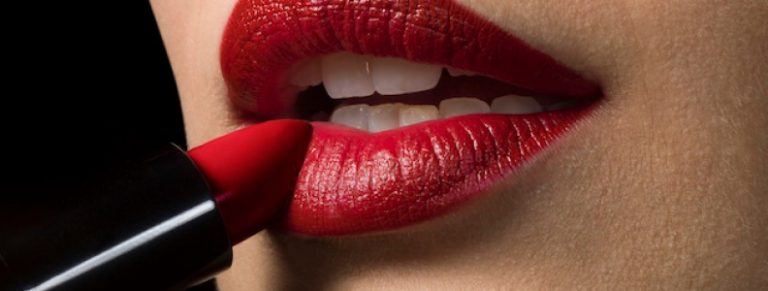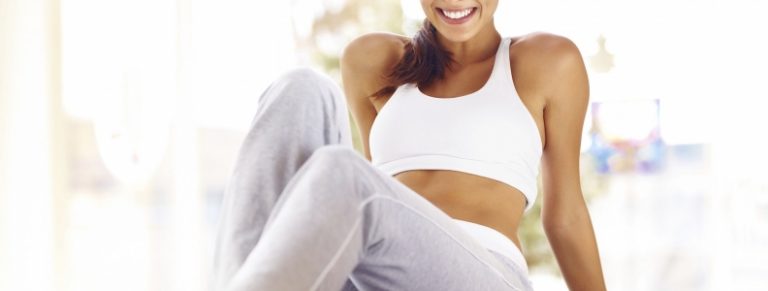CoolSculpting vs. Liposuction
We all know the key to maintaining a healthy weight and a fit physique is exercise and a healthy diet. But not all areas of our body respond the same way. If you have areas of your waistline, abdomen, thighs, or axilla (near the armpit), for example, that don’t seem to cooperate, you may have considered plastic surgery or other fat removal procedures to help you achieve the body shape and contour you desire. And you might be confused by the options available to you.
The most popular methods to remove unwanted fat in specific areas of the body include liposuction and procedures using external devices: external ultrasound, RF (radiofrequency), and CoolSculpting®.
In today’s article, I’ll compare liposuction to CoolSculpting and explain the benefits and risks of each.
What is liposuction?
Liposuction is a surgical procedure designed to improve the shape and contour of defined body areas. The goal is to reduce an area like the abdomen, thighs, or waistline to create a smoother, more pleasing contour and balanced appearance. Liposuction is not for weight loss but for those stubborn areas that just don’t seem to change with diet and exercise. Other names for liposuction include lipoplasty and body contouring.
Am I a good candidate for liposuction?
Patients who are seeking liposuction include both men and women who have been struggling to improve the contour of their bodies. Some patients seek liposuction when they are at ideal weight and health and include personal trainers, athletes, yoga instructors—individuals who ultimately decide to undergo this simple and safe cosmetic procedure to improve the areas that simply resist diet and exercise.
Good candidates for liposuction include men and women who:
- Are in good health without conditions that could complicate surgery (e.g., restricted blood flow, coronary artery disease, or diabetes)
- Have fat deposits and loose skin that resist diet and exercise, such as problem areas of the outer or inner thighs, hips, and belly, and axilla (near the armpit)
- Who maintain a stable body weight
What should I expect from my liposuction procedure?
The first step is a thorough consultation with your Board Certified Plastic Surgeon to share your goals and concerns, evaluate your health and lifestyle, and determine the best course of treatment.
At the time of your procedure:
- Your surgeon will draw the treatment areas on your body and will confirm areas to be treated before surgery.
- You will be sedated with general anesthesia.
- A solution is injected and a small tube (cannula) is connected to a vacuum to suction the fat from your body. (There are a few different liposuction techniques, but all use a cannula.)
- The surgical team will monitor your heart rate, blood pressure, and blood oxygen level throughout the procedure.
You will wake up from your procedure with a compression garment over the treated areas. This garment helps reduce and control swelling and compresses skin to the newly contoured areas.
You will go home the day of the procedure and you’ll want to make sure you have someone drive you home.
Some swelling, bruising, and discomfort are normal and it resolves on its own, usually within one to two weeks. Sutures are removed in seven to ten days. Most patients can return to work within two to four days, but strenuous activity is to be avoided for at least three weeks. Your surgeon will tell you when you can start to exercise again.
Measurable results are typically visible right after surgery and become more noticeable over several weeks, but healing and stabilizing takes time. Be patient—it can take months for the “new you” to be fully realized.
While many physicians can “technically” perform liposuction, extensive experience, skill, and an artistic eye are required to achieve the best results. I use small instruments and a focus on proportion, balance, and beauty to allow for gentle and precise sculpting with smooth, predictable outcomes.
What areas of the body can liposuction target?
Liposuction treatment can smooth, flatten, reduce, or otherwise address your:
- Abdomen
- Hips
- Thighs
- Buttocks crease
- Back
- Armpits
- Knees
- Mons Pubis
What are the risks of liposuction?
As with any surgery, liposuction carries the risk of complications, such as bleeding, a reaction to anesthesia or lidocaine, or infection. Other possible complications specific to liposuction include:
- Contour irregularities
- Temporary pockets of fluid (seromas) under the skin (these can be drained with a needle)
- Temporary or permanent numbness in the affected area or temporary nerve irritation
- Kidney and heart problems caused by the shifts in fluid levels during the procedure (rare unless large volume liposuction is being performed)
Talk to your surgeon about these risks and how they may apply to you.
What is the typical cost of liposuction?
Liposuction costs approximately $2,200 per area. The most popular areas for liposuction include:
- Abdomen
- Hips
- Back and flank
- Inner thighs
- Outer thighs
What is CoolSculpting?
CoolSculpting® is a branded, FDA-approved form of fat reduction called cryolipolysis. It is a non-surgical procedure to freeze away fat cells. CoolSculpting and other forms of cryolipolysis use freezing temperatures to break down fat cells. These temperatures are regulated to not affect or harm other cells.
During the procedure, the practitioner vacuums the skin above the area of fatty tissue into an applicator that cools the fat cells and numbs the area. You may feel a cooling sensation during this procedure. The frozen, dead fat cells are metabolized and they are then excreted from your body through your liver within several weeks of treatment.
What is radiofrequency lipolysis (RF treatment)?
Radiofrequency lipolysis is a non-surgical fat reduction procedure that uses a radiofrequency to heat the fat. Instead of freezing the fat, as in CoolScutlpting, these devices kill fat cells with heat. The applicator does not come in contact with your skin and remains approximately one centimeter from the skin as it heats the fat. The heat is regulated to not affect or harm other cells.
The process is not painful, although some patients may experience mild discomfort. You may experience redness after RF treatment that can last up to 24 hours. Choose an experienced provider, such as a Board Certified Cosmetic Surgeon, who offers FDA cleared technologies for RF treatment.
What is external ultrasound treatment?
Also referred to as ultrasound-assisted liposuction (UAL), this is a relatively new FDA-approved technology that liquefies fat cells before their removal—a process called cavitation. This procedure typically requires fluid injection. External ultrasound utilizes a circular handpiece that is passed on the surface of the skin for several minutes after either ingestion of a large quantity of fluids or injecting numbing medication underneath the skin, which acts as a medium for the conduction of the ultrasound energy.
Note that this differs from the traditional internal ultrasound-assisted liposuction, which is a surgical procedure.
Am I a good candidate for CoolSculpting, RF treatment, or external ultrasound?
Good candidates for nonsurgical treatment of fat are women and men within 10-20 pounds of their target weight. Places of bulge, rather than areas of overall thickness, do best with these techniques.
What areas of the body does CoolSculpting target?
CoolSculpting is FDA-cleared for the treatment of visible fat bulges:
- Under the chin
- Under the jawline areas
- Thigh
- Abdomen
- Back
- Around the bra area
- Underneath the buttocks (also known as banana roll)
- Upper arm
Is CoolSculpting painful?
The Coolsculpting experience is different for everyone. Any pain related to cryolipolysis is primarily experienced during the procedure itself. You may experience discomfort from the numbness that is caused by the freezing applicator, or you may feel pinching and pulling sensations as the fat cells are frozen and pulled out.
Is RF painful?
RF treatment is similar to Coolsculpting except you feel heat and not cold, and the devices do not touch your skin.
What results can I expect from a CoolSculpting or RF treatment procedure?
Most CoolSculpting and RF procedures take around an hour, however, you will likely need multiple sessions (often three procedures per treatment area or more). After the procedure, it may take four to six months for the fat cells to leave the body. During that time, the area of fat treated will decrease by an average of 20 percent. Some patients may see up to a 35 percent reduction in fat in the targeted area.
There is little to no downtown or recovery time. Some people report soreness at the site of the CoolSculpting procedure.
Is CoolScultping safe?
CoolSculpting is a relatively safe, in-office procedure. The pain is minimal. You may experience short-term redness, swelling, bruising, and skin sensitivity at the treatment site.
However, the American Society of Aesthetic Plastic Surgery has reported that 1 out of every 138 treatments results in Paradoxical Adipose Hyperplasia (PAH)—a condition solely attributed to the CoolSculpting device. PAH results in damage to the tissue in the targeted area and creates a deformity much larger in size than the original fat. The condition does not resolve on its own, and unlike regular fat tissue, PAH does not respond to weight loss. The only method of removing PAH is through surgery. PAH was in the news recently, when supermodel Linda Evangelista filed a lawsuit alleging that a CoolScultping procedure left her permanently disfigured.
What does CoolSculpting cost?
Clinics offering CoolSculpting will provide a personalized plan that typically ranges between $2,000 and $4,000 for one treatment per area. You will require three sessions per area to reduce fat by 35%.
For example, a series of treatments for the inner thighs will range between $3,900 – $4,800 and a treatment plan for the abdomen will cost approximately $7,800.
Which Option is Best?
The choice between CoolSculpting and liposuction depends on your treatment goals.
CoolSculpting and RF devices are designed to treat fat in a localized area, such as in the love handles or outer thighs. You can expect mild to moderate improvement in the area being treated. You may require multiple treatment sessions. While the percentage of fat in a specific area may be reduced by up to 35%, it is important to note that this is not a contouring procedure. Changes in the treated area may become apparent as early as three weeks after treatment, and the most dramatic results can be seen one to three months after each treatment. It may take up to a year to see complete results.
Liposuction removes the majority of unwanted fat after one surgical treatment. It is more useful for removing larger areas of excess fat, or if you desire a dramatic change in body contour. Liposuction can be used to contour areas that are irregular or to help with the symmetry of an area. Overall reduction in fat and improved contour is noticeable within days after the procedure, and you will see full results in three to six months. Occasionally, patients may desire an additional treatment to address areas that have some skin laxity or volume asymmetries after surgery and healing.
Consult With a Board Certified Plastic Surgeon Before You Decide
Consulting a Board Certified Plastic Surgeon is an important part of your decision-making.
If you are interested in learning more about liposuction and whether it is a good fit for your goals, contact us at 678.566.7200 to schedule a consultation in our Alpharetta or Midtown Atlanta offices. During your personal consultation, I will listen to your concerns and goals and conduct a thorough evaluation of your health, activities, general lifestyle, and family history.
Together, you will determine what treatment is best suited to your personal needs and goals.





